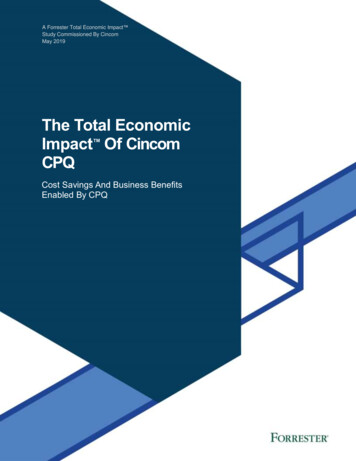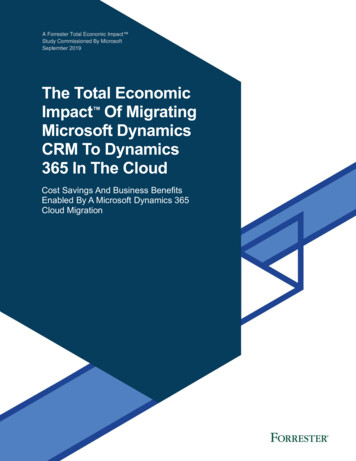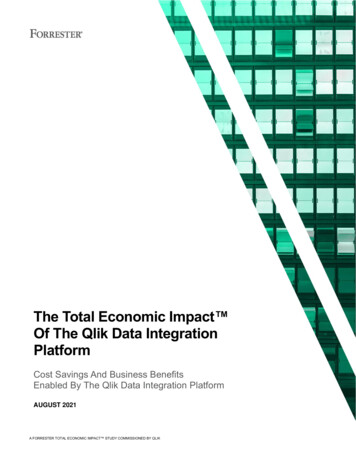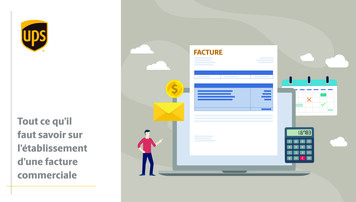
Transcription
A Forrester Total Economic Impact Study Commissioned By CincomMay 2019The Total EconomicImpact Of CincomCPQCost Savings And Business BenefitsEnabled By CPQ
Table Of ContentsExecutive SummaryKey Findings11TEI Framework And Methodology4The CPQ Customer JourneyInterviewed Organization55Key Challenges before Cincom CPQ5Key Results6Analysis Of BenefitsCost Saved From Improved Order AccuracyEngineer Productivity8Reduction In Developer Time Managing The Previous Solution9Time Savings On Quote Process10Unquantified Benefits11Flexibility12Analysis Of CostsCincom Annual License FeesProfessional Services And Hosting FeesFinancial SummaryCincom CPQ: OverviewAppendix A: Total Economic ImpactProject Director:Amy Harrison77141415181920ABOUT FORRESTER CONSULTINGForrester Consulting provides independent and objective research-basedconsulting to help leaders succeed in their organizations. Ranging in scope from ashort strategy session to custom projects, Forrester’s Consulting services connectyou directly with research analysts who apply expert insight to your specificbusiness challenges. For more information, visit forrester.com/consulting. 2019, Forrester Research, Inc. All rights reserved. Unauthorized reproductionis strictly prohibited. Information is based on best available resources.Opinions reflect judgment at the time and are subject to change. Forrester ,Technographics , Forrester Wave, RoleView, TechRadar, and Total EconomicImpact are trademarks of Forrester Research, Inc. All other trademarks are theproperty of their respective companies. For additional information, go toforrester.com.
Executive SummaryKey BenefitsModern sales organizations must meet the expectations of their customersby making complex offerings appear simple, maximizing the value of eachdeal and the speed that the market demands. Companies are increasinglylooking for a configure price quote (CPQ) system that will move beyondbasic functionality to shorten deal cycle times, increase sales conversions,and improve order accuracy. Ultimately, firms can leverage Cincom CPQto improve the overall customer experience for buyers and sellers.Costs saved from improved orderaccuracy:Cincom provides a CPQ solution that simplifies complicated sellingprocesses by digitally transforming business rules, workflows, and productconfigurations. Manufacturers with complex, configurable products benefitfrom the rules engines that Cincom CPQ delivers, which results in fast,accurate quotes and increased efficiency on the factory floor. This resultsin more profitable orders delivered with speed and accuracy. 6.2 millionEngineer productivity: 1.6 millionCincom commissioned Forrester Consulting to conduct a Total EconomicImpact (TEI) study and examine the potential return on investment (ROI)enterprises may realize by deploying Cincom CPQ. The purpose of thisstudy is to provide readers with a framework to evaluate the potentialfinancial impact of Cincom CPQ on their organizations. To betterunderstand the benefits, costs, and risks associated with this investment,Forrester interviewed the applications manager for a vehicle manufacturerwith a go-to-market strategy that involves both dealers and direct sellers.Prior to using Cincom CPQ, sellers were forced to engage in an entirelymanual quoting process. To collect customer requirements, a salespersonwould have a conversation with the buyer, revisit previous purchasehistory to collect old specifications, and manually update the quote.Because there was little to no interaction with the manufacturer, theprocess left both companies open for pricing and configuration errors.Time savings on quote process: 471,289With the adoption of Cincom CPQ, the organization saved millions fromimproved accuracy of orders, gained 2 million from engineering staffproductivity improvement, and reduced the order to cash cycle time.Key FindingsQuantified benefits. The interviewed organization experienced thefollowing risk-adjusted present value (PV) quantified benefits:› Costs saved from improved order accuracy. Reducing the number oferrors, or change orders, required to ship and invoice vehicles not onlysaves dollars but has other positive downstream effects. Over threeyears, a 33% reduction in errors provided a better customer experiencefor both the dealer and its end customers. This error reduction wasworth nearly 6.2 million dollars to the organization over three years.› Increased engineer productivity on the manufacturing line. Theimplementation of Cincom CPQ helped the engineering teams recognizethat 80% of their vehicles contained similar parts, leading them todevelop a more modular versus custom product catalog. This allowedthe organization to create an engineering configurator to assist withprebuild. The organization reported a 20% engineering time savings,which was worth more than 1.6 million dollars over three years.1 The Total Economic Impact of Cincom CPQ
ROI359%Benefits PV 8.95 millionNPV 7 millionPayback 6 months› Reduction in developer time managing the previous solution.Because of the business and configuration rules engines that CincomCPQ delivers, the organization was able to reduce the number ofdevelopers managing the solution to just one person for each of thethree business units. Once the initial deployment happened, theorganization was able to reduce the team by three full-time employeesat a savings of 662,000 to the organization.› Time savings on quote process. In the past, if a company had anysemblance of a quoting system, requirements gathering was still entirelymanual and on the shoulders of the dealer with little help from thefactory. That process could drag out for weeks or months. Cincom CPQenabled a 30% reduction in the sales cycle, saving the manufacturermore than 471,000 over three years.Unquantified benefits. The interviewed organization experienced thefollowing benefits, which are not quantified for this study:› Reduced risk from sales turnover. Specialized salespeople aredifficult to find and take a long time to train. Cincom CPQ allowsorganizations to capture product knowledge and institutionalize theconfiguration and quoting process. As experienced sales individualsinevitably leave the company, rigorous processes protect the dealer fromtheir IP walking out the door.› Enabled “getting in front of the RFP” and increased sales.Salespeople work to cultivate and build buyer relationships so when thetime is right, they are positioned to capitalize on a business opportunity.When that opportunity emerges, sales needs to beat competitors to thespec in hopes of controlling the bid. Cincom CPQ enabled dealers toquickly work up a quote, moving into the review process faster and moreeasily. By providing the path of least resistance to the dealers to producea fast, accurate bid response, dealers could work on more bids,therefore increasing win rates.› Improved order to cash cycle time. By creating the infrastructureneeded for fast, accurate product information exchange between thefactory and the dealers, the organization improved order accuracy.Using Cincom CPQ, the organization uncovered that up to 80% of thevehicles contained repeat parts; the manufacturing line was effectivelyplanned, ultimately speeding up the shipping and invoice times for ashorter cash cycle time.Costs. The interviewed organization experienced the following riskadjusted PV costs:› Annual license costs totaling 294,816 over three years. Theinterviewed organization paid annual license fees for Cincom CPQ. Theorganization added an additional business unit in Years 1 and 2.› Professional services and hosting fees of 722,300 over threeyears. The interviewed organization described internal costs forprofessional services and hosting fees.› Implementation costs totaling 396,900. The interviewed organizationdescribed the internal costs for the implementation team during theinitial year and the year it added the new business unit.› Administrative costs for ongoing maintenance of 539,174 overthree years. The interviewed organization noted that Cincom CPQrequired minimal ongoing management and maintenance. The companymanages its Cincom CPQ deployments with a lean team of four people.2 The Total Economic Impact of Cincom CPQ
Forrester’s interview with an existing customer and subsequent financialanalysis found that the interviewed organization experienced benefits of 8,956,342 over three years versus costs of 1,953,210, adding up to anet present value (NPV) of 7,003,132 and an ROI of 359%.Benefits (Three-Year)Financial SummaryTotalbenefits PV, 8.9M 6.2MPaybackperiod: 6 months 1.6M 661.7KTotalcostsPV, 2.0MInitialYear 1Year 2Year 33 The Total Economic Impact of Cincom CPQCosts saved fromimproved orderaccuracyEngineerproductivity 471.3KReduction inTime savings ondeveloper timequote processmanaging theprevious solution
TEI Framework And MethodologyFrom the information provided in the interview, Forrester has constructed aTotal Economic Impact (TEI) framework for those organizationsconsidering implementing Cincom CPQ.The objective of the framework is to identify the cost, benefit, flexibility, andrisk factors that affect the investment decision. Forrester took a multistepapproach to evaluate the impact that Cincom CPQ can have on anorganization:The TEI methodologyhelps companiesdemonstrate, justify,and realize thetangible value of ITinitiatives to bothsenior managementand other keybusinessstakeholders.DUE DILIGENCEInterviewed Cincom stakeholders and Forrester analysts to gather datarelative to Cincom CPQ.CUSTOMER INTERVIEWInterviewed one organization using Cincom CPQ to obtain data withrespect to costs, benefits, and risks.FINANCIAL MODEL FRAMEWORKConstructed a financial model representative of the interview using theTEI methodology and risk-adjusted the financial model based on issuesand concerns of the interviewed organization.CASE STUDYEmployed four fundamental elements of TEI in modeling Cincom CPQ’simpact: benefits, costs, flexibility, and risks. Given the increasingsophistication that enterprises have regarding ROI analyses related to ITinvestments, Forrester’s TEI methodology serves to provide a completepicture of the total economic impact of purchase decisions. Please seeAppendix A for additional information on the TEI methodology.DISCLOSURESReaders should be aware of the following:This study is commissioned by Cincom and delivered by Forrester Consulting.It is not meant to be used as a competitive analysis.Forrester makes no assumptions as to the potential ROI that otherorganizations will receive. Forrester strongly advises that readers use their ownestimates within the framework provided in the report to determine theappropriateness of an investment in Cincom CPQ.Cincom reviewed and provided feedback to Forrester, but Forrester maintainseditorial control over the study and its findings and does not accept changes tothe study that contradict Forrester’s findings or obscure the meaning of thestudy.Cincom provided the customer name for the interview but did not participate inthe interview.4 The Total Economic Impact of Cincom CPQ
The CPQ Customer JourneyBEFORE AND AFTER THE CPQ INVESTMENTInterviewed OrganizationFor this study, Forrester interviewed a Cincom CPQ customer that:› Is a multinational vehicle manufacturing company with a set ofcomplex products.› Sells directly and via its dealer network in North America andexclusively through a dealer network outside of the United States.Forrester interviewed one division of this multinational company. Withinthis division, three companies are using Cincom CPQ. The analysis willreflect the numbers and business model from that organization.› The business unit has just under 1 billion in net sales.› The interviewed division sells primarily through a dealer network.Key Challenges before Cincom CPQBefore the investment in Cincom CPQ, the organization describedchallenges that slowed the speed of its sales and contributed tounprofitable deals. The application manager lamented: “The dealer isresponsible for putting together the specifications [for each quote]. Thequote would go back and forth to the customer, with no visibility to thefactory about what was being pitched. This would lead to a lot ofguessing about how long things would take to manufacture and howmuch it would cost.”› A cumbersome quoting process lengthened sales cycles. Theinterviewed organization sells a highly configurable product thatpreviously had little pre-engineering. Product specialists, who areresponsible for collaborating with sales, worked to build manual quotesfrom often outdated product sheets. These quotes were built with littleinteraction from the factory about manufacturing timelines or actualcosts, requiring many revisions and lengthening the sales process.› The quoting process provided little factory visibility, losingopportunity to maximize production processes. The quotingprocess lacked clear communication between the dealer and thefactory, providing little visibility about how to plan the mainmanufacturing pipeline. In many cases, the applications managerreported, the factory may have been completely unaware of an orderuntil it was ready to be built.5 The Total Economic Impact of Cincom CPQ“Best-case scenario, they mighthave an application withcanned descriptions with theproduct. Worst-case scenario,they would write everythingdown on the back of a napkin,then figure it out over dinner.”Applications manager,manufacturer
› Out-of-date information caused costly errors. The organization’sbusiness partners often had no quoting system. Those that hadprogressed beyond paper were using some form of a spreadsheet or ahomegrown tool that required manual processes to keep the productdescriptions and pricing current. When configuration requirements andpricing are not kept up to date, salespeople are predisposed tobuilding a vehicle riddled with errors, leaving both the dealer andmanufacturer open for financial exposure. The applications managerstated: “There was a high level of risk that sales would quotesomething that we physically could not build. If you are quoting a halfmillion-dollar product, correcting one or two errors can take you intothe red for that deal.”› There was high risk of sales turnover, putting the dealers’businesses in jeopardy. Salespeople in this industry are highlyspecialized, and there is a steep learning curve before they areproductive. Further, there may only be one person in a dealer who hasthe knowledge to respond to a request for proposal (RFP). Theinterviewed organization experienced its dealers going out of business,in part because of frustrated salespeople leaving. This had a materialimpact on the sales numbers in each dealer’s territory. The applicationmanager said, “If a dealer can’t recover from the salesperson leaving,we have to go through the long process of finding a new dealership inthat territory.”“I am of the belief that anycompany that has a complexconfigurable product shouldhave a CPQ applicationbecause the alternative isgoing back to paper.”Applications manager,manufacturerKey ResultsThe interview revealed that key results from the Cincom CPQ investmentinclude:› Automation of the quoting process. The business previouslyworked under the premise that each vehicle manufactured wascustom. Implementing Cincom CPQ allowed the business to forcesome rigor around its product configuration requirements,documentation, and pricing information to create visibility into neworders being quoted and ultimately purchased. This createdefficiencies for the factory production processes. The applicationmanager said: “We discovered we actually had about 80% repeatablecontent from every order that comes through Cincom CPQ. Thisenabled us to create an engineering configurator. Engineers are now,in an automated fashion, able to map their processes and build somematerials knowing that they’re going to get some repeatable data. It’sstill a customized, specialty vehicle, but it does save engineering timebecause 80% of that unit is preconfigured or can be automated. That’stime that they would have had to spend touching it in the past.”› Improved accuracy. Cincom CPQ significantly reduces the number oferrors, or change orders, required by the factory. The applicationmanager told Forrester, “In the past, the final quote cycle might havehad a 14-day review window, and we’ve pushed that so when theorder is received, it’s almost immediately bookable because we havepushed all of that review out in front of the order receipt.”› Simplified solution management. Implementing Cincom CPQsolutions forces organizations to take a hard look at their pricingpolicies, engineering configurations, and product descriptions to createan effective quote-to-cash set of repeatable processes. But, once thishard work is done, the team required to run and manage the CincomCPQ solution is lean.6 The Total Economic Impact of Cincom CPQ“We’ve used our CPQapplication as a recruitmenttool when we bring on newdealerships. It’s helped usexpand our dealer channel orrecruit more qualitydealerships based on havingthose applications in place.”Applications manager,manufacturer
Analysis Of BenefitsQUANTIFIED BENEFIT DATATotal BenefitsBENEFITYEAR 1YEAR 2YEAR 3TOTALPRESENTVALUECosts saved from improvedorder accuracy 1,764,000 2,910,600 2,910,600 7,585,200 6,195,868Engineer productivity 400,400 800,800 800,800 2,002,000 1,627,471Reduction in developer timemanaging the previoussolution 266,085 266,085 266,085 798,255 661,714Time savings on quoteprocess 143,873 215,809 215,809 575,491 471,289Total benefits (risk-adjusted) 2,574,358 4,193,294 4,193,294 10,960,946 8,956,342Cost Saved From Improved Order AccuracyThe interviewed organization hoped that deploying Cincom CPQ wouldeliminate costly errors and change orders. Before CPQ, the manualquoting process left the company at risk for mistakes because proposalswere built using out-of-date pricing and product specs. The organizationreported a 33% decline in change orders after implementing CincomCPQ.The table above shows the total of allbenefits across the areas listed below,as well as present values (PVs)discounted at 10%. Over three years,the interviewed organization expectsrisk-adjusted total benefits to be a PVof nearly 8.9 million.Said the applications manager: “We had a unit that made it all the way tothe factory without a front axle, which wasn’t accounted for in thefinancials or procurement process. That one component is enough tomake a profitable unit red. Errors would happen regularly simply becausethere was no oversight making sure the order was properly configured.They were relying on a person going through and catching it.”From the interview, Forrester assumes:› Each error costs an average of 20,000, based on the average dealvolume and the price range of product components. (The interviewedorganization sells parts ranging from a small vehicle part to a 35,000chassis.)› Based on revenues disclosed in the annual report and the averagecosts for the vehicles produced, the annual number of vehicles sold is1,175.› Only half (588) of the orders had errors for each year of the three-yearanalysis.› There was a 33% reduction in change orders due to the engineeringconfigurator that the Cincom CPQ system enabled, according to theapplications manager.› In Year 1, the company added a second business running CincomCPQ. In Year 2, the organization began using Cincom CPQ in a thirdbusiness unit, which accounts for the increase in benefits beginning inYear 2.7 The Total Economic Impact of Cincom CPQ 6.2 millionthree-yearbenefit PV70%Costs saved fromimproved orderaccuracy: 70% of totalbenefits
Because order sizes can vary and some vehicle models are moreexpensive than others, Forrester risk-adjusted the results downward by25%, yielding a three-year risk-adjusted total PV of 6,195,868.Costs Saved From Improved Order Accuracy: Calculation TableREF.METRICCALC.YEAR 1YEAR 2YEAR 3A1Cost of an error 20,000 20,000 20,000 20,000A2Number of errors588588588588A3Cumulative error costsA1*A2 11,760,000 11,760,000 11,760,000A4Reduction in errors20% in Year1, 33% inYears 2 and320%33%33%AtCosts saved from improved order accuracyA6*A7 2,352,000 3,880,800 3,880,800Risk adjustment 25% 1,764,000 2,910,600 2,910,600AtrCosts saved from improved order accuracy(risk-adjusted)Engineer ProductivityPrior to CPQ, the interviewed organization custom-built each vehicle.After the CPQ deployment, the organization analyzed its componenthistory data and discovered that 80% of the orders had repeatableparts. According to the applications manager, the engineersexperienced a 20% time savings in prebuild engineering because theycould now leverage these repeatable builds. He said: “We baseengineering improvements on this data. We have a larger teamsupporting sales engineering and contract administration. But, on a perunit basis, there’s less touch on engineering, planning, andmanufacturing. We can move much more quickly to the factory thanwe’re used to be able to.”Forrester assumes that:› The organization has 100 engineers earning 55 per hour. They work2,080 hours during the year.› The organization added a company in the second year. To account forthis, Forrester modeled a 10% reduced effort in the first year and 20%in the second and third years.› There is a 50% reduction to productivity benefits to account for thepercentage of time saved applied to additional work.The amount of productivity savings will vary based on:› The amount of repeatable builds and/or customization acrossproducts.› The number of engineers in the organization.› The fully loaded compensation of engineers by tenure andgeographical region.To account for these risks, Forrester adjusted this benefit downward by30%, yielding a three-year risk-adjusted total PV of 1.6 million.8 The Total Economic Impact of Cincom CPQBecause of Cincom CPQ,engineers discovered that80% of their orders hadrepeatable builds, savingtime on the factory floor.
Engineer Productivity: Calculation TableREF.METRICCALC.YEAR 1YEAR 2YEAR 3B1Number of engineers100100100100B2Hourly rate per person 55 55 55 55B3Annual hours worked2,0802,0802,0802,080B4Reduced effort by engineers10% in Year 1,20% in Years 2and 310%20%20%B5Productivity recapture50%50%50%50%BtEngineer productivityB1*B2*B3*B4*B5 572,000 1,144,000 1,144,000Risk adjustment 30% 400,400 800,800 800,800BtrEngineer productivity (risk-adjusted)Reduction In Developer Time Managing ThePrevious SolutionBecause of the functionality built into the tools, organizations can reducethe support needed to keep the CPQ application and the correspondingconfigurations current and running optimally. The applications managersaid, “Prior to CPQ, we had several people at every company supportingthese applications, and now we are able to manage these applicationswith a really small team.”› The organization had at least two people managing the CPQapplications for each of the three companies Forrester discussed.› The interviewee reported that the organization could reduce the teamto a core unit of four developers running and managing the CPQsolution.The dollars saved will vary depending on the following factors:› Salaries may be different across companies and geographies.› Organizations may not move at the same pace as the companyForrester interviewed, thereby taking longer to be positioned to reduceheadcount.To account for these risks, Forrester adjusted this benefit downward by10%, yielding a three-year, risk-adjusted total PV of 661,714.9 The Total Economic Impact of Cincom CPQ7% 661,714three-yearbenefit PV
Reduction In Developer Time Managing The Previous Solution: Calculation TableREF.METRICCALC.YEAR 1YEAR 2YEAR 3C1Number of workers (saved)3333C2Fully burdened developer salary 98,550 98,550 98,550 98,550CtReduction in developer time managing theprevious solutionC1*C2 295,650 295,650 295,650Risk adjustment 10% 266,085 266,085 266,085CtrReduction in developer time managing theprevious solutionTime Savings On Quote ProcessIn addition to improved order accuracy, a major driver for deploying CPQis getting quotes in the hands of customers faster. Before CPQ, a dealermight have needed several cycles of communication and weeks tocreate a quote. Worse, it might have chosen to pass on a bid if it provedtoo difficult to respond. After deploying Cincom CPQ, the applicationsmanager reported saving 34 days in the quote process.5% 471,289three-yearbenefit PV› The time to produce a quote decreased from 48 days, which includedfour revision cycles, to 14 days with two revision cycles. This saved atotal of 68 days in Year 1 and 102 days in the second and third years,with the addition of another company ramped on Cincom CPQ.› Both product managers and engineers are involved in the quotingprocess, and Forrester assumes 10% of their time is spent working onquotes.› The manufacturer has 90 dealers, and Forrester assumes one quoteper year from half of the dealers.› Forrester applies a 50% reduction to productivity benefits to accountfor the percentage of time saved applied to additional work.The amount of productivity savings will vary based on:› The complexity of the quoting process and inefficiencies prior toimplementing CPQ.› The fully loaded compensation of product managers and engineers bytenure and geographical region.› The number of dealers and proposals created.To account for these risks, Forrester adjusted this benefit downward by10%, yielding a three-year risk-adjusted total PV of 471,289.10 The Total Economic Impact of Cincom CPQTime savings on quoteprocess: 5% of totalbenefits
Time Savings On Quote Process: Calculation TableREF.METRICCALC.YEAR 1YEAR 2YEAR 3D1Days in quote process and number of cyclesbefore Cincom12 days*4 cycles484848D2Days in quote process and number of cyclesafter Cincom7 days*2 cycles141414D3Number of brands using Cincom CPQ233D4Days saved in new quote process(D1-D2)*D368102102D5Fully burdened product manager annualsalary( 157,950/261)*D4 41,152.72 61,728.59 61,728.59D6Fully burdened engineer annual salary( 114,750/261)*D4 29,897.55 44,845.83 44,845.83D7Number of proposals per year (90 dealers)45454545D8Average percentage of time spent doingquote-related work10%10%10%10%D9Productivity recapture50%50%50%50%DtTime savings on quote process(D5 D6)*D7*D8*D9 159,858 239,787 239,787Risk adjustment 10% 143,873 215,809 215,809DtrTime savings on quote process (riskadjusted)Unquantified BenefitsThe interviewed customer identified the following additional benefits ofusing Cincom CPQ but were not able to quantify the benefits at thepresent time.› Reduced risk from sales turnover. Dealers make large investmentsfinding and training specialized salespeople. The knowledge that nichesalespeople gain is often only in their heads and not documented.Cincom CPQ mitigates this risk by capturing important product andprocess information, which can be leveraged by future sellers. Theapplications manager reported: “A huge amount of our productknowledge was tribal, so it would be held in the heads of engineersand product managers. We are at a high amount of risk based on theproficiency of a dealership for specific territory. You couldn’t hire ageneric salesperson to sell one of these products; the learning curve isdeep. CPQ allows you to more easily staff the sales department ofdealerships. We institutionalized product and configuration informationwhich reduced the risk that if you lost a very knowledgeable sales repin a specific region, you may not be able to replace them.”11 The Total Economic Impact of Cincom CPQCincom CPQ has beenused as a recruitmenttool to bring on morequality dealerships.
› Enabled “getting in front of the RFP” and increased sales. Sales isa volume game, and any roadblocks that stop sellers from competingmight as well be detour signs. Successful companies win morebusiness by enabling sales to quickly and easily create and deliveraccurate proposals. “Salespeople will tell you the most critical thing ina bid situation is getting that specification in front of the bid committeewhile they are still forming their product requirements. You want to bein as early as possible when that bid opens and as close to the marketrate as possible.” The application manager continued: “Depending onthe workload, or what the dealership thought its chances to win were,you might have situations where they would just pass. CPQ easestheir ability to generate a quality specification. It means that we aregetting our spec in front of more customers.”› Improved order to cash cycle time. By providing improved productdescriptions, configuration rules, and current pricing information, theaccuracy of the orders improved, and the product was ready to buildfaster. Ultimately, this allowed the manufacturer to shorten its cyclefrom order to cash. The applications manager said, “Every timesomething would change, they would basically have to review theentire configuration repeatedly because they couldn’t tell what theimpact was. When the business could say, ‘We’re done; we’re ready toinvoice this,’ this is when the impact was made to order cycle time.”The applications manager reported a 30% improvement in order tocash.FlexibilityThe value of flexibility is clearly unique to each customer, and themeasure of its value varies from organization to organization. There aremultiple scenarios in which a customer might choose to implement CPQand later realize additional uses and business opportunities, including:› Improved dealer experience. In this industry, manufacturer-dealercontracts are usually exclusive, which puts increased burden on themanufacturer to optimize its relationship with the dealer. Theapplication manager described the value specifically to increasing thecompany’s channel: “Dealers are making a pretty big choice when theydecide to hook up with us.” He continued, “During dealershiponboarding, I’ve had dealers say, ‘You know, this is what we’ve be
5 The Total Economic Impact of Cincom CPQ The CPQ Customer Journey BEFORE AND AFTER THE CPQ INVESTMENT Interviewed Organization For this study, Forrester interviewed a Cincom CPQ customer that: › Is a multinational vehicle manufacturing company with a set of complex products. › Sells directly and via its dealer network in North America and











